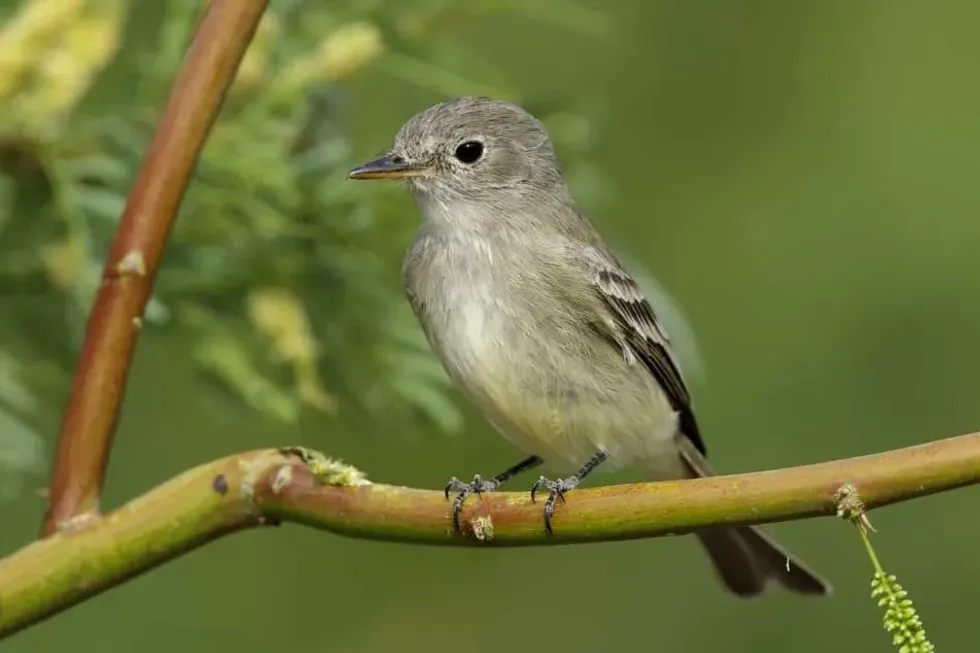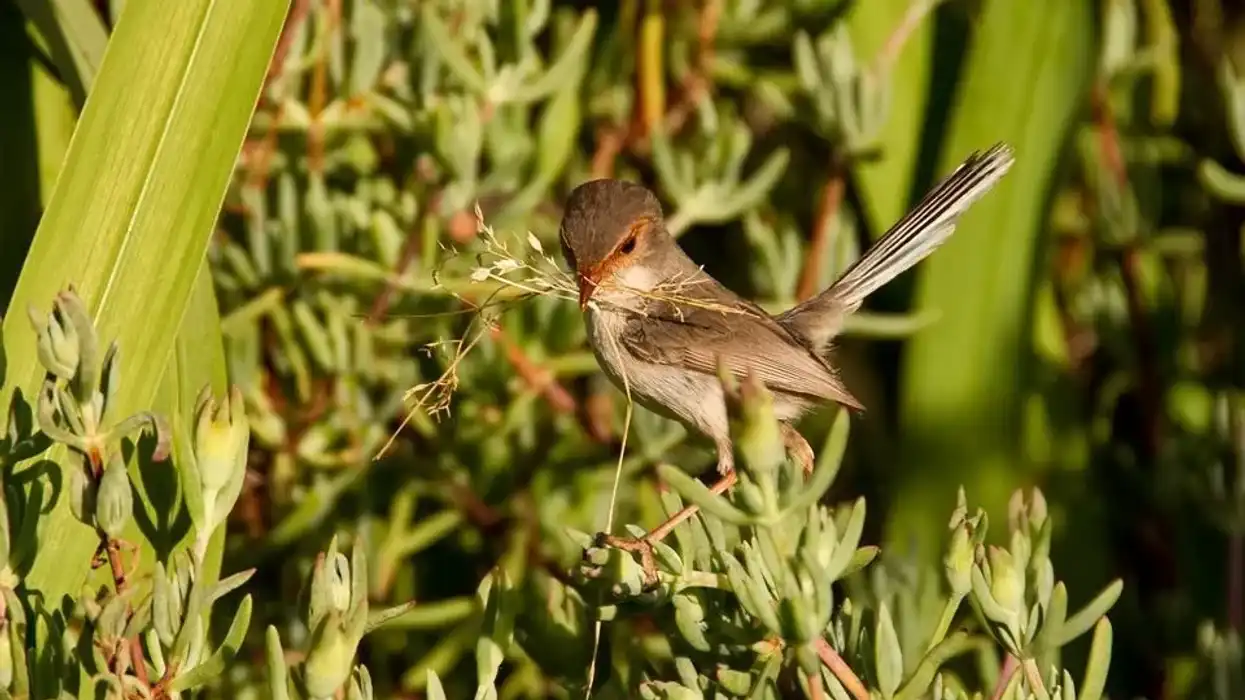Are you excited to learn some amazing facts about a certain species of flycatchers? Then keep reading this article.
The gray flycatcher, Empidonax wrightii, is a bird of the order Passeriformes, family Tyrannidae. A huge range of these North American birds is spread across the Great Basin, though a smaller population can be found in other countries like Canada.
They prefer the sagebrush habitat of the Great Basin but also thrive in the arid desert climate and open habitats dominated by trees like pine, juniper, gray oak, and others.
Trees like pine and juniper may form an overstory at the edges of the brushes, while sagebrush forms an understory. Dominantly gray in color with a darker tail and wings, long narrow beaks, and yellow eyering, these western birds do not enjoy extensive migratory status owing to their short-distance migration during early spring/fall and wintering.
Their breeding season is in April, after a short courtship period. Males and females build nests in evergreen trees and shrubs and lay eggs in their nests.
They wildly defend their territories from other bird species with loud calls and make their presence felt by bursting into a song.
These flycatchers swoop down from low perches to catch insects from the ground or on top of vegetation. Sometimes, they also catch insects from the air or foliage and twigs while hovering over them.
Read on to find some more exciting details on these western birds, and if you like this article, check out tyrant flycatcher and willow flycatcher.
Gray Flycatcher Interesting Facts
What type of animal is a gray flycatcher?
The gray flycatcher, Empidonax wrightii, is a species of flycatcher from the order Passeriformes, family Tyrannidae.
What class of animal does a gray flycatcher belong to?
These birds belong to the class Aves of the animal kingdom.
How many gray flycatchers are there in the world?
This bird species is not facing any potential risk or concern. In fact, their global population has been reported to be increasing with time. However, there is no data available that could show the exact number of these birds currently inhabiting the planet.
Where does a gray flycatcher live?
This flycatcher species is mainly found in the Great Basin of the United States. They have been spotted in the high deserts and bordering mountains and foothills. A small population of these birds is found in Canada.
What is a gray flycatcher's habitat?
The gray flycatcher is fond of the shrubsteppe habitat or sagebrush habitat that dominates the Great Basin region of the United States. These birds are also accustomed to the extreme hot and cold days in the deserts.
They can also survive open habitats dominated by evergreen trees like white fir, incense cedar, juniper, pine, and Gary oak, to name a few.
Who do gray flycatchers live with?
Not much research is available on whether these flycatchers stay in groups. However, the male and female of the species build their nests together and defend their territory during the breeding season in April. Also, often paired flights are noticed among this species during the courtship period.
How long does a gray flycatcher live?
Not enough information is available to estimate the average life span of this family of birds from North America.
How do they reproduce?
In April, during the breeding season, these flycatchers build their nest with twigs, strips of tree bark, straws in evergreen trees or shrubs. The nest is mostly built by females at about a height of 10 ft (304.8 cm) or less from the ground.
The nests range about 2.4 in (6.1 cm) in length and 5 in (12.7 cm) in width with an interior depression. Nests are often laid in loose colonies.
The females lay three or four creamy-white eggs, which are then incubated for 14 days.
Both parents take care of the young chicks and bring them food in the nest when they are unable to survive on their own. Within 16 days of hatching, these young birds take their first flight and leave the nest, and soon become independent.
What is their conservation status?
Under the International Union for Conservation of Nature or IUCN Red List, these birds have been enlisted as Least Concern. They are currently facing no threats or concerns that could pose any potential risk to their population, so no conservation step is not needed at this moment either.
Gray Flycatcher Fun Facts
What do gray flycatchers look like?
The gray flycatcher, Empidonax wrightii, is a small slim bird from the Tyrannidae family. Hailing mainly from the Great Basin of North America, these pale gray flycatchers are covered in pale gray feathers on the top and white feathers on the underside of their body.
This species also has a long sleek yellow or pale pink bill with a black tip and yellow eyering.
The birds have a darker tail and short dark gray wings with two wing bars. Their primary feathers do not extend beyond the tertials, and this makes the tail look longer.
How cute are they?
These tiny western flycatchers from North America are very cute with their tiny grayish bodies and long beaks.
How do they communicate?
The song of the males of this species can be heard from low and favored perches, and this song has been associated with the intention to drive rival species away and establish territories, unlike the wintering birds who are often seen to sing a song.
How big is a gray flycatcher?
The gray flycatchers range somewhere between 5.5-5.9 in (14-15 cm). These birds are slightly smaller than a great crested flycatcher.
How fast can a gray flycatcher fly?
This western bird watches out for its prey from a low perch. Once it spots its prey, it swoops down from the perch and catches insects in its bill. So these birds can fly swiftly while foraging on prey, and flycatchers are also known to hover, but the exact speed at which they fly is unknown.
How much does a gray flycatcher weigh?
The weight of these birds can range between 0.4-0.5 oz (11-14 g).
What are the male and female names of the species?
The male gray flycatchers of this species are called cocks, while the females are called hens.
What would you call a baby gray flycatcher?
The baby bird is called a chick.
What do they eat?
These western flycatchers are omnivores. Primarily they prey on insects. They swoop down from low perches near shrubs or lower branches of trees and catch the prey in their bill. Their food habit includes a range of insects, from grasshoppers and beetles to wasps, moths, and antlions. Other than that, they are also known to feed on small fruits.
Are they dangerous?
The bird has not been known to cause any harm to people. They only get territorial with rival species.
Would they make a good pet?
These North American birds should not be kept as pets, as they are wild birds, and if the exact required habitat for the birds is not imitated, then it would only harm the birds.
Did you know...
The gray flycatchers are known to be rivals with a similar species of birds, known as the dusky flycatcher. Their breeding habitat often overlaps, and the males call loudly to defend their territories against one another. Also, much like the dusky flycatcher, adults of this similar species molt into new plumage in the wintering grounds.
The gray catbird, from the same order as gray flycatcher, is known to be a gray and black bird.
Behavior of the gray flycatcher
The gray flycatcher regularly dips its tail while it is perched on a low branch or on top of shrubs. They are known to flick their tail often.
How are gray flycatchers affected by climate change?
The overall population range of the gray flycatchers is mostly limited to North America. However, due to climate change, they might lose 80% of their geographical range in the future.
They are also known to migrate. Migration is observed in early spring or fall, and they arrive during breeding in April and wintering in August. This migration range will be affected as well.
Here at Kidadl, we have carefully created lots of interesting family-friendly animal facts for everyone to discover! Learn more about some other birds from our black-capped gnatcatcher facts and common kingfisher facts pages.
You can even occupy yourself at home by coloring in one of our free printable gray flycatcher coloring pages.










